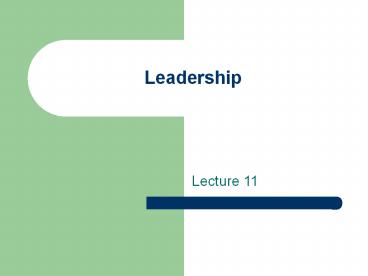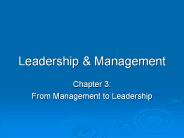Leadership - PowerPoint PPT Presentation
Title: Leadership
1
Leadership
- Lecture 11
2
Leadership definitions
- Leadership can be defined as a process or
property - As a process, it is the influence to shape the
groups or organizational goals, motivate
behaviour toward the achievement of those goals
and help define group or organization culture. - As a property, it is a set of characteristics
attributed to the individuals who are perceived
as leaders.
3
Leadership and management
- Give example for leaders in organization
- Are there differences between leaders and
managers?
4
Power and leadership
- Power is the ability to affect the behaviour of
others. There are five kinds of power in any
organization - Legitimate power. It is the power granted through
the organizational hierarchy. It is the same as
authority. All managers have legitimate power
over subordinates - Reward power. It is the power to give rewards
such as salary increases, promotions, praise,
recognition and interesting job assignments.
5
Forms of power
- Coercive power. It is the power to force
compliance by means of psychological, emotional
or physical threat It may take the form of
verbal reprimand, written reprimands,
disciplinary layoffs, demotion and termination. - Referent power. The personal power that is given
to someone based on identification, imitation.
6
Forms of power
- Expert power. It is the personal power given to
someone based on the information or expertise
they possess. The more important the information
is and the fewer people who have access to it,
the greater is the expert power possessed by the
individual.
7
Using power
- The legitimate request. It involves the manager
requesting that the subordinates comply as they
recognize that the organization has given the
right to manager to make the request. - Instrumental compliance. It is based on reward
power and it is based on reinforcement theory of
motivation. - Coercion- by using coercive power. When the
manager suggests that subordinate will be
punished, coercion is being practiced.
8
Theories of leadership
- Theory of the traits of a leader.
- Gizeli is the author of the theory. He examines
traits of managers, who are successful in their
work. These traits include - Abilities to inspect, to direct the work of
others, to organize and integrate their actions - Need of professional advancement and
achievements, intelligence, need of
self-actualization, self-confidence and ability
to take decisions.
9
Conclusions from Gizelis theory
- The successful leaders have higher needs of
achievements, are ready to work on their own and
are confident in the job they are doing - The leaders are communicative, able to estimate
others in the right way.
10
Behavioral approach to leadership
- It focuses on what leaders do, not on what traits
they have. The behavioral approach is presented
by - The Michigan studies. There are two forms of
leader behavior - Job-centered leader behavior. It means that
leader is paying close attention to subordinates
work, explain work procedures and is interested
in their performance. - Employee-centered leader behaviour. In this case,
leader is interested in developing working group
and ensuring that employees are satisfied with
their job.
11
The Ohio state studies
- There are two basic leader styles
- Initiating structure behaviour. The leader
clearly defines the leader-subordinate role so
everyone knows what is expected, establishes
formal lines of communication and determines how
tasks will be performed. - Consideration behaviour. The leader shows concern
for subordinates and attempts to establish
supportive climate.
12
Conclusions of the Ohio state studies
- Leaders who exhibit high levels of both behaviors
would tend to be more effective than other
leaders - Employees of supervisors who ranked high on
initiating structures were higher performers but
with lower level of satisfaction
13
Managerial Grid
- It is a model of leadership based on two forms of
leader behavior - Concern for people
- Concern for the production.
- There are 5 leader styles
- Task management or authoritarian management
having high concern for the production and low
for people - Liberal management style with high concern for
people and low concern for the production - Management of the orphanage. It is typical for
low concern on both dimensions. - Management of the middle road. It is
characterized by average concern for people and
production. - Democratic management.
14
Situational approaches to leadership
- The appropriate leader behavior varies from one
situation to another - The goal is to identify key situational factors
and to specify how they interact to determine
leader behavior.
15
Fiedlers contingency theory
- Fiedler identifies two styles of leadership-
task-oriented and relationship-oriented. - The style of leader behavior is a reflection of
the leaders personality. - Fiedler is using the Least preferred colleague.
To use this measure, the manager is asked to
describe the person with whom he or she is able
to work at least well. The higher numbers are
associated with a relationship orientation,
whereas low points mean that the leader is task
oriented.
16
Fiedlers model
- Favorableness of the situation. It means that
appropriate leader behaviour varies from one
situation to another. The key situation factor is
the favorableness of the situation. This factor
is determined by three things - leader-member relations
- Task structure
- Position power.
17
Task structure
- It is the degree to which the group task is well
defined. In routine task, the group has
standardized procedures and precedents to rely
on. - If the task is unstructured, then leader plays an
important role.
18
Position power
- It is the power in leaders position. Position
power is strong if the leader can assign work,
reward and punish employees.
19
Flexibility of leader style
- Leader style is fixed and can not be changed.
When the leaders style and situation do not
match, the situation should be changed to fit the
leader style.
20
The Path-Goal theory
- Authors of the theory are Evans and House.
- The theory is based on the expectancy theory.
- The functions of the leader are to make valued or
desired rewards available and to clarify to
subordinates what kind of behavior will lead to
goal accomplishment.
21
Path-goal theory
- There are 4 types of behaviours
- Directive leader lets the subordinates know what
is expected from them, giving guidance and
direction - Supportive leader.
- Participative leader, who is consulting
subordinates and allowing participating in the
decision making. - Achievement oriented leader. He is setting goals,
expecting high performance from subordinates,
encouraging them.
22
Situational factors
- Leader style depends on situational factors
- Personal characteristics of subordinates
- Environmental characteristics of the work place































